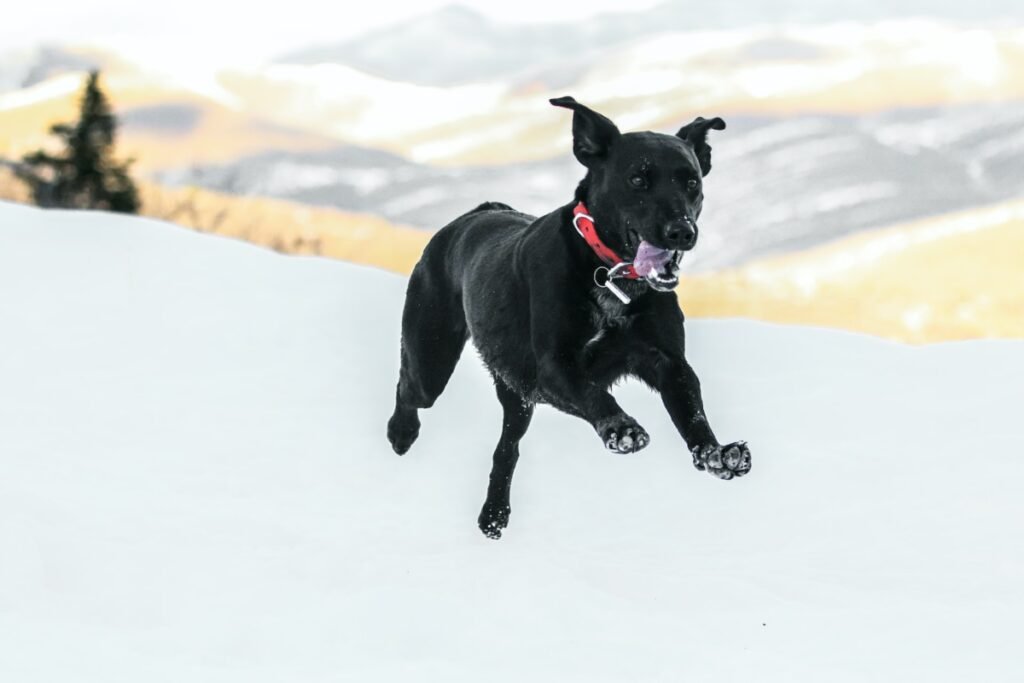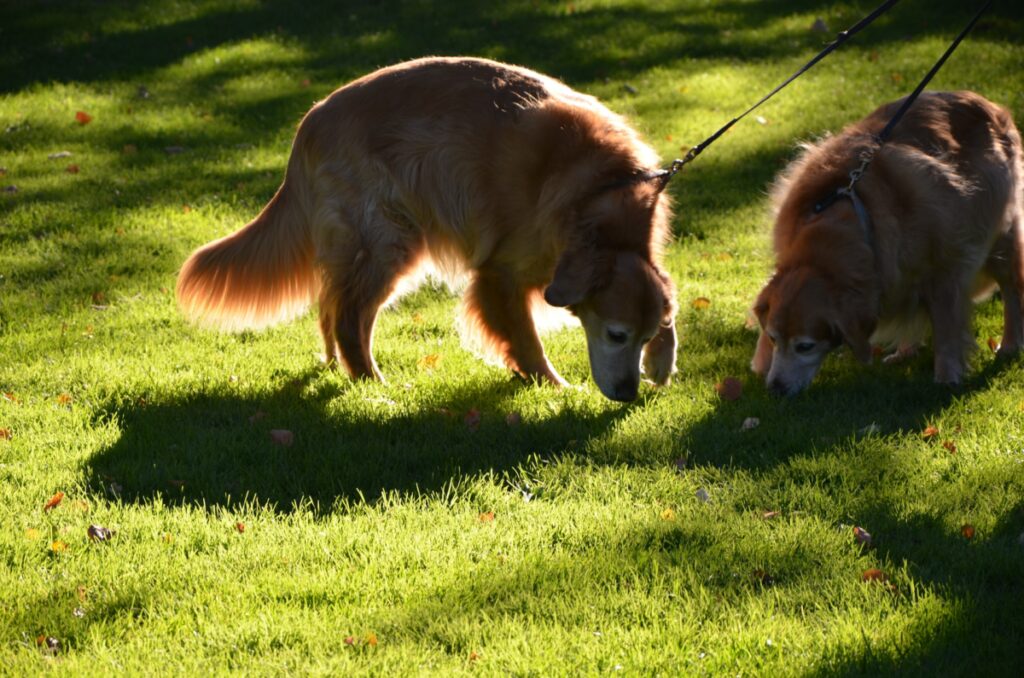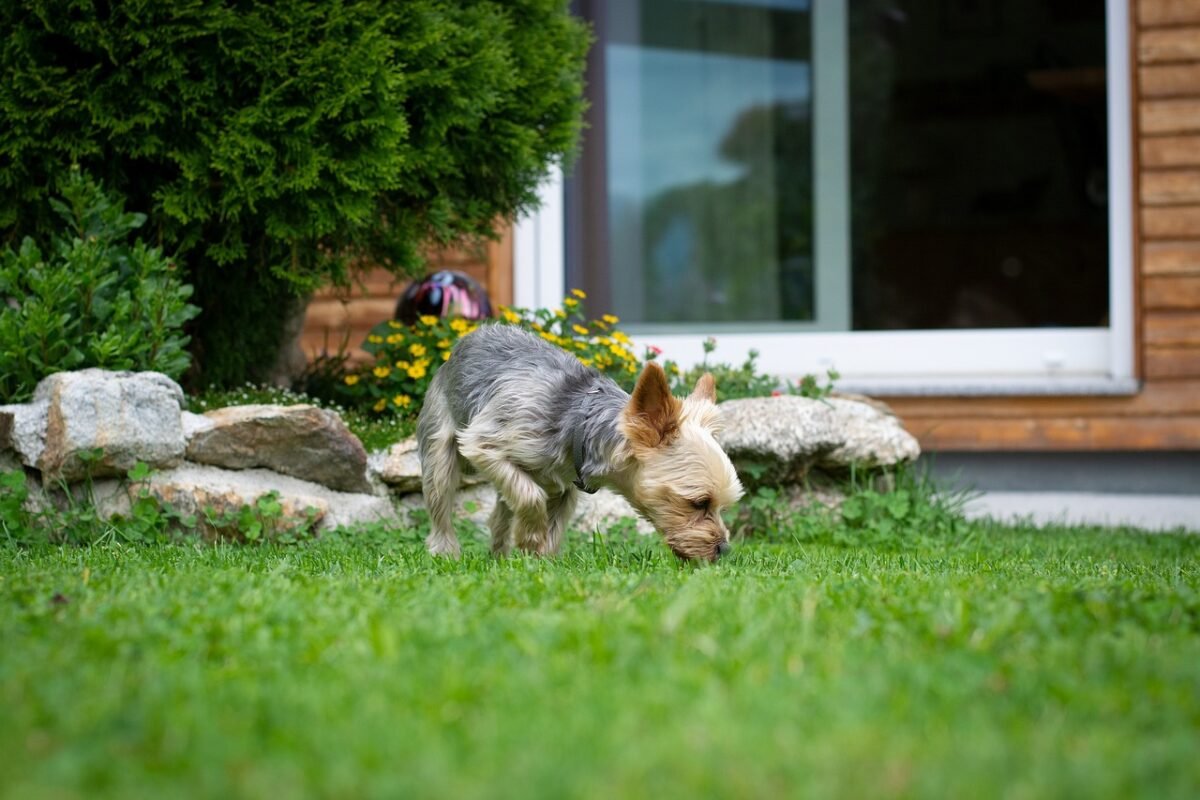We're an affiliate
We hope you love the products we recommend! Just so you know, we may collect a share of sales or other compensation from the links on this page at no additional cost to you. Thank you if you use our links, we really appreciate it!
Seasoned dog owners will attest to how these furry creatures can surprise them with whacky behavior every now and then.
As a responsible pet parent, it is normal to be concerned about your dog’s puzzling habits, especially when they come out of the blue.
Circling behavior in dogs is one of those activities which may appear cute and cringe at the same time depending on the frequency or severity.
Why Is My Dog Walking in Circles – Normal Circumstances
There are a few cases where occasional dog spinning would be considered a normal canine behavior stemming from their instincts.
They include:
1. Investigative behavior
Dogs have a very keen sense of smell and sometimes they can spin in circles before settling down as a way of understanding their surroundings.
You can know if your pup is investigating a new ground if they’re making turns on a particular spot and digging into the ground with the front paws.
2. Scent-marking and territorial behavior
Have you noticed your dog walking in circles before lying down? This could be a scent-marking behavior aimed at claiming new territories.
Dogs can leave a scent trail by spinning around a particular spot and stamping the ground before laying to rest.
3. Preparing to rest
Your dog may turn around a particular spot several times before laying down to rest as a way of creating a comfy space.
This instinctual behavior stemmed from the wild dogs who would circle a suitable area to lay down the vegetation before sleeping.
Dogs in the wild also did this as a way of scanning the immediate area for potential predators before heading into slumber.
4. Playfulness and excitement
Sometimes there’s nothing to worry about when your dog spins while walking because it could be a sign of playfulness and excitement.
Your active pup may wag their tail furiously and jump while moving ahead in circles as a show of excitement when embarking on a long-awaited walk or outdoor activities.
5. Before pooping
A dog may walk in circles and trample down the vegetation before emptying their bowels. They do this to create a good space for pooping by securing their footing.

Dogs poop by exposing themselves in vulnerable positions making it important for them to assess the area before leaving the message.
Why Is My Dog Walking in Circles – Abnormal Circumstances
Unfortunately, some abnormal issues may cause your furry friend to walk in circles.
In most cases, dogs with underlying medical conditions affecting coordination and balance can walk with an unstable gait.
Luckily enough, you can suspect illness as a cause for your dog’s circling behavior when it’s accompanied by other worrying signs and symptoms.
The following are some of the medical reasons why your dog may not walk normally:
1. Vestibular disease
Vestibular syndrome, also known as ‘canine vertigo’ is a condition that affects the dog’s coordination and balance system.
Affected dogs may move in circles due to the disorientation caused by the malfunctioning vestibular system.
Some of the other common signs of vestibular syndrome in dogs include tilting the head, flickering of the eyes, excessive drooling, and walking sideways.
Vestibular syndrome in dogs can easily be mistaken as a stroke because the symptoms are closely related.
2. Neurological disorders
Neurological disorders can also be the main cause of your dog’s circling behavior in addition to other related symptoms.
The most common neurological disorders responsible for this side effect are; stroke, seizures, brain tumors, hydrocephalus, and inflammation of the brain.
In addition to repetitive circling behavior, dogs with neurological conditions can show uncontrolled movements, unstable gait, bathroom accidents, and twitching.
3. Orthopedic issues
Orthopedic conditions in dogs such as arthritis and joint-related issues can be painful to dogs and cause them to lose normal gait while walking.
Dogs with joint problems will often walk abnormally or in rounds as a way of easing pressure on the affected limbs.
Other symptoms to watch out for orthopedic issues in dogs include limping, stiffness, and difficulty in walking up.
Your vet may prescribe a joint supplement to improve your dog’s joint health or to strengthen the bones.
4. Ear infections
Infection in the inner part of the ear is perhaps one of the most common medical reasons why dogs may walk while making turns.
This condition can cause the dog to lose their balance and coordination, making them spin while walking.
If you suspect ear infections as the possible cause for circling behavior, you can watch out for other signs including tilting the head on one side, smelly ears, head-shaking, and ear-scratching.
Ear infections are serious conditions in dogs and without proper intervention, the infection can evolve to cause major problems.
Your vet should be able to diagnose and prescribe a simple treatment for your dog’s ears after which they may recommend regular ear-cleaning to prevent further infections.
5. Cognitive Dysfunction Syndrome (CDS) in senior dogs
Cognitive Dysfunction Syndrome (CDS) is a condition that affects older dogs, similar to Alzheimer’s disease in humans.
Dogs can experience cognitive decline as they advance in years, and they may exhibit circling behavior when walking as a result of confusion or disorientation.
Other symptoms of CDS include drastic changes in sleep patterns, loss of house-training skills, and decreased interaction with family members.
If you suspect your senior dog may have CDS, consult with your veterinarian to develop a management plan.
6. Stress and anxiety-related circling
Stress and anxiety in dogs can also cause them to walk in circles. Affected pups may make a few turns as a way to cope with their nervousness or to release pent-up energy.
This behavior is often accompanied by other signs of nervous tension, such as pacing, panting, destructive behavior, or excessive barking.
Identifying the source of stress and providing appropriate interventions, such as positive reinforcement training or environmental enrichment, can help alleviate emotional distress.
The Link Between Circling and Breed Predispositions
Whereas any dog breed can exhibit circling, this behavior can be more predisposed to certain breeds than others.
A few dog breeds may walk in circles and spin due to normal reasons stemming from their breeding traits.
1. Breeds that are more prone to circling behavior
Herding breeds such as German shepherds and Border Collies have an instinctual desire to control livestock.
These breed predisposition makes them easy to spin as they mimic how their ancestors circled in the field to gather and guide livestock.
The hunting group like terriers is another category of dogs predisposed to walking in circles. These dogs were originally bred to hunt game or rodents.
They can show circling behavior as a way of mimicking their hunting escapades while digging or chasing after game.
2. Understanding breed-specific instincts
Pet parents need to understand that their dog’s behavior is heavily rooted in their ancestral DNA.
If you own a herding or hunting breed, they may not necessarily do what they were bred for but they have the instincts to run in circles as a way of reminiscing their origin.
Despite having a dog with the predisposition to run in circles, you need to watch out for excess and intervene when the behavior becomes a problem.
Observing Your Dog’s Body Language While Circling
You should always observe your dog’s circling behavior to determine if there’s a cause for concern.
1. Signs of discomfort and pain
Observing the signs of discomfort and pain will help in determining if the circling behavior is normal or not.
Before checking for pain, you need to watch out for the frequency and intensity of the circular motions made by your dog.
A few circles made before lying down or using the toilet are quite normal, but when the behavior is accompanied by pain then you should worry.
Some painful symptoms to watch out for include yelping, whining, difficulty lying down, or excessive head shakes.
2. Indication of excitement or joy
As we mentioned earlier, your furry friend may jump and run in circles as a sign of excitement and joy.
Some of the other cues to show playfulness in circling behavior include tail wagging, flattened ears, and anticipation.

3. Recognizing stress and anxiety cues
You can know if your dog is emotionally disturbed when walking in circles if they show some signs of stress or anxiety.
Restlessness, panting, and excessive barking are some of the signs that can point to the emotional health condition of your dog.
How To Stop a Dog from Walking in Circles
If you’re concerned about your dog’s circling behavior, you can take an active approach to re-train them on how to walk properly.
It’s important to mention that if this behavior is caused by medical reasons, you should only rely on help from the vet for an appropriate cure.
1. Providing a safe and comfortable environment
As a responsible pet parent, you need to ensure that your dog’s environment is safe and comfortable for them.
Make sure to clear the walkways and remove all potential hazards on the way to guarantee a smooth walk for your canine friend.
The other way to address this problem is by providing a comfortable dog bed for your pup’s age and preferences.
Furnishing your dog’s sleeping area will reduce the instances they have to circle and dig as a way of curving out a comfy resting spot.
2. Enriching mental stimulation and physical activity
Providing your dog with regular exercise and mental activity is a nice way of supporting their emotional health.
Offer your dog some interactive toys and puzzle games to stimulate their minds and drive boredom away.
Taking your dog for daily walks and runs is an efficient way of expending their pent-up energy reducing chances of circling at home due to anticipation.
3. Using positive reinforcement training techniques
If you notice your dog is spinning or moving in circles, you can redirect them to walk properly by using a leash and harness.
Reward your dog with tasty treats or praises every time they walk in a continuous forward motion.

Encouraging your beloved canine to walk properly may take some time but with patience and consistency, they should be on track.
4. Seeking professional help for behavioral issues
Sometimes you may need the help of an animal behaviorist to retrain your dog, especially if the problem is obsessive or compulsive.
Speak with your vet about all the possible solutions for your dog’s behavior. Your dog may be put on anxiolytic medication such as benzodiazepines and azapirone, if they have anxiety issues.
Preventative Measures
1. Regular veterinary checkups
It’s always a good idea to take your dog to the vet’s office for a comprehensive health assessment.
Your vet will do a physical exam on your dog and perform blood work to diagnose the common illnesses.
If your dog has episodes of seizures, your vet may advise you to take a clear video when the problem strikes for proper diagnosis.
2. Proper socialization and training
Socializing your canine friend from a young age can help to prevent anxiety or stress-related behaviors.
Exposing them to various environments, people, and other animals can help build their confidence and reduce the likelihood of excessive circling.
3. Establish a routine for your dog
Dogs can do best when subjected to a predictable routine and when they know what is expected of them.
We strongly suggest that you establish a consistent daily routine for sleeping, waking, feeding, exercise, and rest. This can help alleviate anxiety and create a sense of security for your dog.
Frequently Asked Questions (FAQs)
1. What are the potential medical reasons for my dog’s circling behavior?
Some of the medical reasons for dog circling behavior include inner ear infections, vestibular disease, neurological disorders, and orthopedic issues.
You should have a chat with your vet to rule out the possible medical conditions related to circling in dogs.
2. Can circling behavior be a sign of stress or anxiety in dogs?
Yes! Circling behavior in dogs can be a sign of emotional distress or anxiety. Stressed dogs may make turns while walking as a way of dealing with their nervous tension.
The other symptoms accompanied by this behavior are panting, excessive barking, and engaging in destructive behavior.
3. Is it normal for puppies to walk in circles during playtime?
Yes! It is completely normal for puppies to exhibit circling behavior when playing.
Puppies are full of energy and may engage in playful circling as a way to express their excitement and fun.
However, if the circling becomes excessive or persistently interferes with their play, it is best to monitor the behavior closely.
4. How can I differentiate between normal and abnormal circling in my dog?
If your dog is circling before doing normal activities like playing, sleeping, or emptying the bowels, then the behavior may be normal.
However, if the circling is sudden, persistent, and excessive, then there should be a reason to worry because it may be due to a medical concern.
An animal behaviorist may help you determine the severity of your dog’s circling behavior and recommend possible solutions if the behavior is of concern.
Conclusion
Your beloved furry friend may walk in circles because of normal reasons and sometimes abnormal reasons.
Making occasional turns before sleeping or pooping is largely considered normal and should not cause an alarm.
Sudden or excessive circling accompanied by other negative symptoms can be a sign that your dog is suffering from a medical condition.
Your vet is best placed to diagnose and determine the causes of this behavior, and to recommend solutions if there’s something to worry about.
Laura is the founder of Furs'n'Paws. She is a also a pet writer and expert with more than 20 years of experience of working with dogs and cats. She developed a very strong love for animals at a young age. Her passion led her to establish a thriving pet sitting and dog walking business in Dubai. As an expert in pet training, behavior, and nutrition, Laura is committed to helping pet owners and pet lovers by offering high-quality information on a wide range of topics.



No responses yet